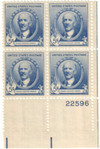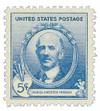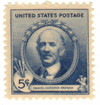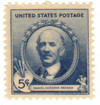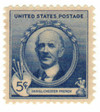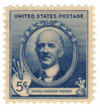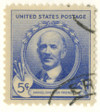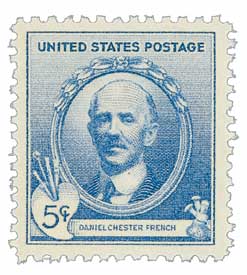
# 887 - 1940 Famous Americans: 5c Daniel Chester French
1940 5¢ Daniel Chester French
Famous Americans Series – Artists
First City: Stockbridge, Massachusetts
Quantity Issued: 21,720,580
Printed by: Bureau of Engraving and Printing
Printing Method: Rotary Press
Perforation: 10 ½ x 11
Color: Ultramarine
Birth Of Daniel Chester French
French was the son Henry Flagg French, a lawyer, judge, and Assistant U.S. Treasury Secretary. Though he showed a talent for drawing as a child, French didn’t discover sculpture until his late teens.
After the family moved to Concord, Massachusetts, in 1867, French met artist Abigail May Alcott (sister of author Louisa May Alcott and the inspiration for Amy in Little Women). Having studied fine arts in Boston, Alcott gave French an introduction to working with clay and encouraged him to pursue a career. He went on to study with the same teachers she had – William Rimmer (anatomy) and William Morris Hunt (drawing). French then spent a year at the Massachusetts Institute of Technology and several years in Florence, Italy, under the instruction of Thomas Ball.
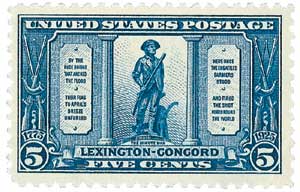
In 1873, family friend, Ralph Waldo Emerson helped French get one of the most important commissions of his career. The city of Concord was preparing for the Centennial of the Revolutionary War Battles of Lexington and Concord and wanted to erect a statue at the North Bridge to commemorate them. Emerson recommended French for the job, and he got it. The people of Concord gave French their family’s militia uniforms so the statue could be as accurate as possible. Several locals also posed to provide models for the head, while the body was based on a famous classical sculpture. Ten Civil War Cannons were melted to provide the bronze for the seven-foot tall statue. It was unveiled on April 19, 1875, with President Ulysses S. Grant, Henry Wadsworth Longfellow, and Ralph Waldo Emerson in attendance.
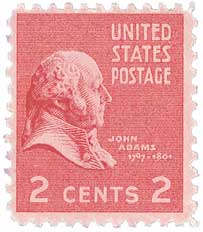
French was just 25 at the time, and had only a few years of education in sculpture. The Minute Man was his first full-sized sculpture and it earned him immediate acclaim. He then established his own studio in Washington, D.C., and began receiving commissions for portrait busts as well as tall figures for public buildings. His renown began to spread and soon, he was hired to sculpt three massive figures for the 1893 World’s Columbian Exposition. Among them was the 65-foot tall Statue of the Republic, a personification of the ideal of the Republic covered in gold leaf. The statue towered over the expo, which was attended by some 27 million people. The recognition he received from that statue made him even more famous, and soon French had more commissions than he could handle. In fact, he often had to book them two to three years in advance.
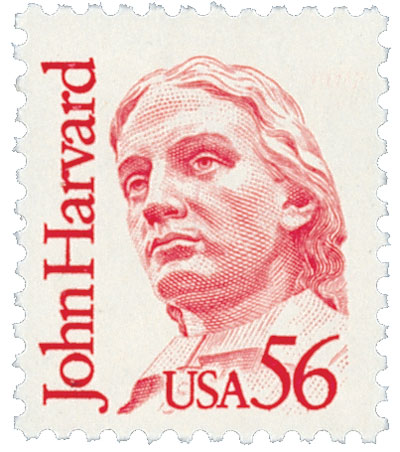
In the coming years, French helped found the National Sculpture Society, became a member of a number of art groups, and received honorary degrees from four universities. He also designed one side of the Pulitzer Prize gold medal (picturing Benjamin Franklin).
In 1914, French was hired for perhaps one of his most famous sculptures, the seated Abraham Lincoln that sits in Lincoln Memorial in Washington, D.C. He made three plaster casts (which are on display at his Chesterwood Studio in Massachusetts) before the final sculpture, which took a year to make, could be completed.
1940 5¢ Daniel Chester French
Famous Americans Series – Artists
First City: Stockbridge, Massachusetts
Quantity Issued: 21,720,580
Printed by: Bureau of Engraving and Printing
Printing Method: Rotary Press
Perforation: 10 ½ x 11
Color: Ultramarine
Birth Of Daniel Chester French
French was the son Henry Flagg French, a lawyer, judge, and Assistant U.S. Treasury Secretary. Though he showed a talent for drawing as a child, French didn’t discover sculpture until his late teens.
After the family moved to Concord, Massachusetts, in 1867, French met artist Abigail May Alcott (sister of author Louisa May Alcott and the inspiration for Amy in Little Women). Having studied fine arts in Boston, Alcott gave French an introduction to working with clay and encouraged him to pursue a career. He went on to study with the same teachers she had – William Rimmer (anatomy) and William Morris Hunt (drawing). French then spent a year at the Massachusetts Institute of Technology and several years in Florence, Italy, under the instruction of Thomas Ball.

In 1873, family friend, Ralph Waldo Emerson helped French get one of the most important commissions of his career. The city of Concord was preparing for the Centennial of the Revolutionary War Battles of Lexington and Concord and wanted to erect a statue at the North Bridge to commemorate them. Emerson recommended French for the job, and he got it. The people of Concord gave French their family’s militia uniforms so the statue could be as accurate as possible. Several locals also posed to provide models for the head, while the body was based on a famous classical sculpture. Ten Civil War Cannons were melted to provide the bronze for the seven-foot tall statue. It was unveiled on April 19, 1875, with President Ulysses S. Grant, Henry Wadsworth Longfellow, and Ralph Waldo Emerson in attendance.

French was just 25 at the time, and had only a few years of education in sculpture. The Minute Man was his first full-sized sculpture and it earned him immediate acclaim. He then established his own studio in Washington, D.C., and began receiving commissions for portrait busts as well as tall figures for public buildings. His renown began to spread and soon, he was hired to sculpt three massive figures for the 1893 World’s Columbian Exposition. Among them was the 65-foot tall Statue of the Republic, a personification of the ideal of the Republic covered in gold leaf. The statue towered over the expo, which was attended by some 27 million people. The recognition he received from that statue made him even more famous, and soon French had more commissions than he could handle. In fact, he often had to book them two to three years in advance.

In the coming years, French helped found the National Sculpture Society, became a member of a number of art groups, and received honorary degrees from four universities. He also designed one side of the Pulitzer Prize gold medal (picturing Benjamin Franklin).
In 1914, French was hired for perhaps one of his most famous sculptures, the seated Abraham Lincoln that sits in Lincoln Memorial in Washington, D.C. He made three plaster casts (which are on display at his Chesterwood Studio in Massachusetts) before the final sculpture, which took a year to make, could be completed.




